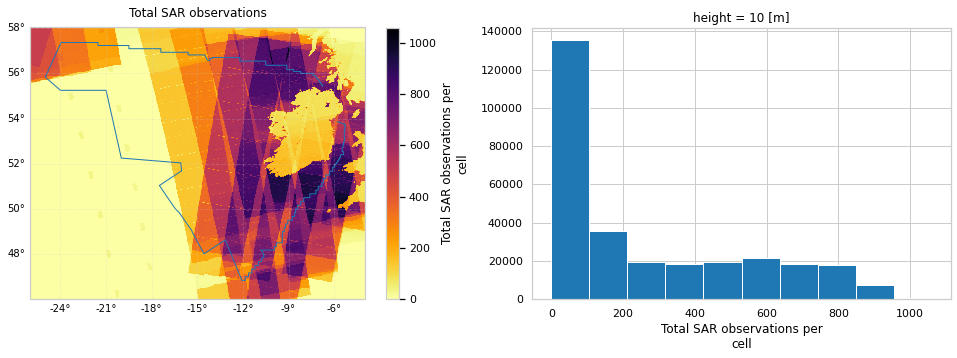Sentinel-1 Wind Data for Irish Continental Shelf region
Contents
Sentinel-1 Wind Data for Irish Continental Shelf region¶
Introduction¶
The European Union Copernicus Earth Observation (EO) programme and services are based on data collected from EO satellites, in particular, the Sentinel satellite missions. This includes the Sentinel-1 mission, which consists of a pair of C-band Synthetic Aperture Radar (SAR) imaging satellites in polar orbit. One of its main objectives is the provision of ocean monitoring services, where its Level-2 Ocean (OCN) products include an Ocean WInd field (OWI) component. This provides gridded estimates of wind speed and direction at 10m above the surface, with a typical spatial resolution of 1 km. Examples of Sentinel-1 SAR usage for ocean wind analysis are described in the following publications:
Ahsbahs et al. (2018) - Applications of satellite winds for the offshore wind farm site Anholt
Ahsbahs et al. (2020) - US East Coast synthetic aperture radar wind atlas for offshore wind energy
This notebook provides details of:
Sentinel-1 wind data products retrieval.
The creation of the Sentinel-1 Zarr wind store that is included in the EOOffshore catalog.
A brief look at this Zarr store, including a demonstration of wind speed calculation.
This Sentinel-1 Zarr store has been uploaded to Zenodo.
How to cite:
O’Callaghan, D. and McBreen, S.: Scalable Offshore Wind Analysis With Pangeo, EGU General Assembly 2022, Vienna, Austria, 23–27 May 2022, EGU22-2746, https://doi.org/10.5194/egusphere-egu22-2746, 2022.
O’Callaghan, D. and McBreen, S.: EOOffshore: Sentinel-1 Wind Data for the Irish Continental Shelf Region, (1.0.0) [Data set], Zenodo, 2022.
Note: more extensive usage of the EOOffshore Sentinel-1 Zarr store may be found in the following notebooks:
Sentinel-1 Wind Data Products¶
The EOOffshore project uses Sentinel-1 Level-2 Ocean (OCN) wind products data set, which provide ocean wind estimates from 2015 to the present day. The following data variables are relevant:
Variable |
Unit |
Height (metres above sea level) |
Description |
|---|---|---|---|
|
\(m/s\) |
10 |
SAR Wind speed |
|
degrees |
10 |
SAR Wind direction (meteorological convention = |
|
Dimensionless |
n/a |
Quality flag taking into account the |
Data products from all Sentinel missions, including those from Sentinel-1 observations, are publicly available via the Copernicus Open Access Hub (COAH). Products are distributed using a Sentinel-specific variation of the Standard Archive Format for Europe (SAFE) format specification. Retrieving products from the COAH is typically a two-stage process using the Sentinelsat library
Query the COAH for all Sentinel-1 Level-2 product identifiers available for a specified time period that are contained within the Irish Continental Shelf (ICS) region
Retrieve product for each identifier listed in the query results
Older data products may no longer be accessible from the COAH, where these are often moved to the Long Term Archive (LTA), (see related discussion). As Sentinel-1 Level-2 products (back to 2015) are also hosted by the Alaska Satellite Facility (ASF), any products no longer available in the COAH set were retrieved from the ASF using the aria2c utility. The following products were retrieved using a combination of the COAH and ASF archives:
Observation / Models |
Satellite |
Product type |
Near-Real-Time |
Processing level |
Level-2 |
Data type |
Gridded (latitude/longitude) |
Horizontal coverage |
Individual products within ICS maritime limits |
Horizontal resolution |
1 km |
Vertical coverage |
Single level |
Temporal coverage |
2015-06-07T18:21:04 to 2021-09-29T18:07:48 |
Temporal resolution |
12-day repeat frequency (6-day with two-satellite Sentinel-A/B constellation) |
Update frequency |
|
File format |
NetCDF-4 |
Total retrieved products |
17,698 SAFE (containing 22,950 NetCDF-4) |
Total products size |
241G |
Sentinel-1 Wind Zarr Store¶
As the retrieved NetCDF products (within the SAFE archives) are Level-2 products featuring heterogeneous curvilinear grids, they were initially regridded to a uniform grid using xESMF. A spatial resolution of 0.03 degrees was specified for this grid, which is similar to resolutions used in earlier Sentinel-1 ocean wind analysis (Ahsbahs et al., 2020; de Montera et al., 2020). Each Level-2 product is associated with an observation time, and it was necessary to assign a time coordinate dimension prior to further processing. Although each product provides a firstMeasurementTime value, this appears to only contain unique values for Single VV (SV) polarization products. For all other products, the “Stop Date and Time” contained in the product filename was used as the unique time coordinate. A height coordinate dimension (10m) was also added for the owi... variables. Using small product batch chunks, a chunked, compressed Zarr store, which is a cloud-optimised format suitable for multi-dimensional arrays, was created by concatenating products along the time dimension. This Zarr store was then rechunked in space (x - longitude, y - latitude dimensions) using Rechunker, where a time chunk size was specified that resulted in a low number of time chunks. This approach is more suitable for subsequent processing of variables over time for Areas Of Interest (AOIs). Retaining only the owi... variables results in considerably lower storage requirements in this final rechunked Zarr store (1.2GB) compared to the original products that were retrieved.
As requested by the Legal Notice on the use of Copernicus Sentinel Data and Service Information, this Zarr store:
Contains modified Copernicus Sentinel data [2015 - 2021].
Sentinel-1 in EOOffshore Catalog¶
Imports required for subsequent processing
%matplotlib inline
import cartopy.crs as ccrs
from intake import open_catalog
import json
import matplotlib as mpl
import matplotlib.pyplot as plt
import seaborn as sns
import shapely.geometry as sgeom
import xarray as xr
sns.set_style('whitegrid', {'axes.labelcolor': '0', "text.color": '0', 'xtick.color': '0', 'ytick.color': '0', 'font.sans-serif': ['DejaVu Sans', 'Liberation Sans', 'Bitstream Vera Sans', 'sans-serif'],})
sns.set_context('notebook', font_scale=1)
Open the catalog and view the Sentinel-1 metadata¶
All EOOffshore data sets, including the Sentinel-1 Zarr store described above, are accessible using the EOOffshore Intake catalog. Each catalog entry provides a description and metadata associated with the corresponding data set, defined in a YAML configuration file. The EOOffshore catalog configuration was originally influenced by the Pangeo Cloud Data Store atmosphere.yaml catalog configuration.
To view the Sentinel-1 metadata:
catalog = open_catalog('data/intake-catalogs/eooffshore_ics.yaml')
catalog.eooffshore_ics_level3_sentinel1_ocn
eooffshore_ics_level3_sentinel1_ocn:
args:
storage_options: null
urlpath: /data/eo/zarr/scihub/s1_ocn/201501_202109/eooffshore_ics_level3_sentinel1_ocn.zarr
description: EOOffshore Project 2015 - 2021 Concatenated Sentinel-1 Level 2 OCN
wind (owiWind...) variable products from Copernicus, for Irish Continental Shelf.
Products have been regridded with xESMF (bilinear) to a Level 3 grid, NW (-26,
58), SE (-4, 46), grid resolution = 0.03 degrees. Contains modified Copernicus
Sentinel data [2015 - 2021].
driver: intake_xarray.xzarr.ZarrSource
metadata:
catalog_dir: /opt/eooffshore/notebooks/datasets/data/intake-catalogs/
tags:
- atmosphere
- wind
- sentinel1
- ocean
title: Sentinel-1 L2 OCN owiWind variables regridded to level 3 Irish Continental
Shelf grid (resolution = 0.03 degrees)
url: https://sentinels.copernicus.eu/web/sentinel/ocean-wind-field-component
Load the catalog Sentinel-1 Zarr store¶
Intake catalog entries typically specify a driver to be used when loading the corresponding data set. The Sentinel-1 entry specifies intake_xarray.xzarr.ZarrSource, a driver implementation provided by the intake-xarray library. This enables NetCDF and Zarr data sets to be loaded using xarray, a library for processing N-D labeled arrays and datasets. As xarray labels take the form of dimensions, coordinates and attributes on top of NumPy-like arrays, it is particularly suited to data sets such as CCMP whose variables feature latitude/longitude grid coordinates.
This intake driver will load the associated dataset into an xarray.Dataset. To enable support for potentially large data sets, the to_dask() function is used to load the underlying variable arrays with Dask, a parallel, out-of-core computing library. The ZarrSource implementation will load the data set variables into Dask arrays, which will be loaded and processed in parallel as chunks during subsequent computation. As discussed above, variable chunk sizes may be specified during Zarr store creation.
Here is the Sentinel-1 store loaded into an xarray.Dataset:
All variables have associated coordinate dimensions:
time- unique observation time of eacb original Level-2 productx(longitude) andy(latitude) - the corresponding coordinate grid generated during regridding with xESMFheight- 10m (above sea level)
A low number of
timechunks have been specified, to support subsequent computation across time for smaller AOI grid coordinates.
ds = catalog.eooffshore_ics_level3_sentinel1_ocn.to_dask()
# Enable consistent variable naming
ds = ds.rename({'owiWindDirection': 'wind_direction', 'owiWindSpeed': 'wind_speed'})
ds
<xarray.Dataset>
Dimensions: (height: 1, y: 401, x: 734, time: 18545)
Coordinates:
* height (height) int64 10
latitude (y, x) float64 dask.array<chunksize=(401, 734), meta=np.ndarray>
longitude (y, x) float64 dask.array<chunksize=(401, 734), meta=np.ndarray>
* time (time) datetime64[ns] 2015-06-07T18:21:04 ... 2021-09-29T...
Dimensions without coordinates: y, x
Data variables:
wind_direction (time, height, y, x) float32 dask.array<chunksize=(18545, 1, 40, 40), meta=np.ndarray>
owiWindQuality (time, height, y, x) float64 dask.array<chunksize=(18545, 1, 40, 40), meta=np.ndarray>
wind_speed (time, height, y, x) float32 dask.array<chunksize=(18545, 1, 40, 40), meta=np.ndarray>
Attributes:
eooffshore_zarr_creation_time: 2022-05-13T14:02:25Z
eooffshore_zarr_details: EOOffshore Project: Concatenated Sentinel...Sentinel-1 wind quality flag¶
Sentinel-1 OCN products contain an owiWindQuality variable, which reflects the quality of corresponding wind variables at a particular time.
Each variable in the Sentinel-1 data set, including owiWindQuality, is loaded into an xarray.DataArray:
The arrays are transposed here to produce more intuitive
timechunk visualisations. This is not required for computation.
ds.owiWindQuality.transpose('height', 'time', 'y', 'x')
<xarray.DataArray 'owiWindQuality' (height: 1, time: 18545, y: 401, x: 734)>
dask.array<transpose, shape=(1, 18545, 401, 734), dtype=float64, chunksize=(1, 18545, 40, 40), chunktype=numpy.ndarray>
Coordinates:
* height (height) int64 10
latitude (y, x) float64 dask.array<chunksize=(401, 734), meta=np.ndarray>
longitude (y, x) float64 dask.array<chunksize=(401, 734), meta=np.ndarray>
* time (time) datetime64[ns] 2015-06-07T18:21:04 ... 2021-09-29T18:07:48
Dimensions without coordinates: y, x
Attributes:
coordinates: lon lat
flag_meanings: good medium low poor
flag_values: [0, 1, 2, 3]
long_name: Quality flag taking into account the consistency_between_...
valid_range: [0, 3]Plot the mean wind quality across time for all grid coordinates¶
According to the Sentinel-1 Product Specification (Issue/Revision: 3/9, Date: 07/05/2021):
“Wind quality flag (
owiWindQuality) values can be 0 (high quality), 1 (medium quality), 2 (low quality) or 3 (bad quality).
Previous analysis of Sentinel-1 OCN products (de Montera et al., 2020) excluded “bad quality” observations (owiWindQuality = 3). Here, the following plots look at mean owiWindQuality across the time dimension:
Mean
owiWindQualityfor all observationsMean
owiWindQuality, excluding “bad quality” observations
Using Dask, the data set loading process is lazy, where no data is loaded inititally. Instead, data loading is delayed until execution time, where variables will be loaded and processed in parallel according to the corresponding chunks specification. Dask arrays implement a subset of the NumPy ndarray interface using blocked algorithms, and the original variable arrays will be split into smaller chunk arrays, enabling computation on arrays larger than memory using all available cores. The blocked algorithms are coordinated using Dask graphs.
Here, mean owiWindQuality over the time dimension is initially determined for all grid coordinates, where Dask graph execution is triggered by calling compute(). The resulting variable values will be contained in a NumPy ndarray.
Graph execution is managed by a task scheduler. The default scheduler (used for executing this notebook) executes computations with local threads. However, execution may also be performed on a distributed cluster without any change to the xarray code used here.
Map plots of variables with grid coordinates may be generated using xarray’s plotting capabilities, and other libraries. To plot mean owiWindQuality:
Specify a suitable projection using Cartopy
Call the variable
xarray.DataArray.plot()Load the ICS maritime limits geometry with Shapely
Specifying a Cartopy projection will use a
GeoAxes, which is a subclass of a regular matplotlibAxes. This may be used to plot the following:ICS boundary
Variable grid (latitude/longitude) lines
Ireland coastline
with open('data/linestring_ics_geo.json') as jf:
icsgeo = json.load(jf)
icsline = sgeom.LineString(icsgeo['features'][0]['geometry']['coordinates'])
MAP_PROJECTION = ccrs.PlateCarree()
def plot_ics_variable(ax: mpl.axes.Axes,
variable: xr.DataArray,
title: str,
vmin: float,
vmax: float = None,
cmap: mpl.colors.Colormap = 'inferno_r'):
# x and y must be specified for 2-d grids
variable.plot(x='longitude', y='latitude', cmap=cmap, vmin=vmin, vmax=vmax, ax=ax)
ax.set_aspect('auto')
# ICS boundary
ax.add_geometries([icsline], MAP_PROJECTION, edgecolor = sns.color_palette()[0], facecolor='none')
# Lat/lon gridlines
gl = ax.gridlines(draw_labels=['left', 'bottom'], alpha=0.2, linestyle='--', formatter_kwargs=dict(direction_label=False))
label_style = {'size': 10}
gl.xlabel_style = label_style
gl.ylabel_style = label_style
ax.set_title(title);
fig, ax = plt.subplots(nrows=1, ncols=2, figsize=(16.5, 5), subplot_kw=dict(projection=MAP_PROJECTION))
ax = ax.flatten()
quality_title = 'Mean wind quality flag'
plot_ics_variable(variable=ds.where(ds.owiWindQuality >= 0).owiWindQuality.mean('time', keep_attrs=True).compute(),
title=f'{quality_title} (all)',
vmin=0,
vmax=3,
ax=ax[0])
ds = ds.where((ds.owiWindQuality >= 0) & (ds.owiWindQuality <= 2))
plot_ics_variable(variable=ds.owiWindQuality.mean('time', keep_attrs=True).compute(),
title=f'{quality_title} (excluding bad quality)',
vmin=0,
vmax=3,
ax=ax[1])

Plot the mean number of SAR observations across time for all grid coordinates¶
A minimum number of SAR observations are required for wind speed analysis (for example, Hasager et al., 2015; Badger et al., 2016). Based on the following plot of total observations per grid cell, it is clear that observations are not uniformly distributed across the Sentinel-1 ICS grid. A histogram of the SAR observations distribution is also displayed, using xarray.plot.hist(), along with corresponding distribution statistics.
ds['total_sar_observations'] = ds.wind_speed.count('time').compute()
ds.total_sar_observations.attrs.update({'long_name': 'Total SAR observations per cell'})
fig = plt.figure(figsize=(16.5, 5))
plot_ics_variable(variable=ds.total_sar_observations,
title=f'Total SAR observations',
vmin=ds.total_sar_observations.min().item(),
vmax=ds.total_sar_observations.max().item(),
ax=plt.subplot(121, projection=MAP_PROJECTION),
cmap='inferno_r')
xr.plot.hist(ds.total_sar_observations.sel(height=10), ax=plt.subplot(122));

ds.total_sar_observations.to_dataframe().total_sar_observations.describe().to_frame().T
| count | mean | std | min | 25% | 50% | 75% | max | |
|---|---|---|---|---|---|---|---|---|
| total_sar_observations | 294334.0 | 254.171346 | 289.59132 | 0.0 | 2.0 | 137.0 | 503.0 | 1060.0 |
Retain only cells with quality in [0, 2] and a minimum number of observations (\(\ge\) 200)¶
Excluding cells with low numbers of SAR observations does not noticeably reduce coverage of Irish offshore AOIs.
ds = ds.where(ds.total_sar_observations >= 200)
fig, ax = plt.subplots(nrows=1, ncols=2, figsize=(16.5, 5), subplot_kw=dict(projection=MAP_PROJECTION))
ax = ax.flatten()
quality_title = 'Mean wind quality flag'
plot_ics_variable(variable=ds.total_sar_observations,
title=f'Total SAR observations (200+)',
vmin=ds.total_sar_observations.min().item(),
vmax=ds.total_sar_observations.max().item(),
ax=ax[0])
plot_ics_variable(variable=ds.owiWindQuality.mean('time', keep_attrs=True).compute(),
title=f'{quality_title} (filtered)',
vmin=0,
vmax=2,
ax=ax[1])

Sentinel-1 wind speed (2015 - 2021)¶
Wind speed is loaded into an xarray.DataArray:
ds.wind_speed.transpose('height', 'time', 'y', 'x')
<xarray.DataArray 'wind_speed' (height: 1, time: 18545, y: 401, x: 734)>
dask.array<transpose, shape=(1, 18545, 401, 734), dtype=float32, chunksize=(1, 18545, 40, 40), chunktype=numpy.ndarray>
Coordinates:
* height (height) int64 10
latitude (y, x) float64 dask.array<chunksize=(401, 734), meta=np.ndarray>
longitude (y, x) float64 dask.array<chunksize=(401, 734), meta=np.ndarray>
* time (time) datetime64[ns] 2015-06-07T18:21:04 ... 2021-09-29T18:07:48
Dimensions without coordinates: y, x
Attributes:
coordinates: lon lat
long_name: SAR Wind speed
standard_name: wind_speed
units: m/sCalculate mean wind speed over time dimension at AOI grid coordinates¶
To perform some analysis at known AOI latitude/longitude coordinates, the xarray.DataArray.sel(..., method='nearest') function may be used to select a subset of the data array (or data set) at coordinates nearest to the specified parameters.
Here, mean wind speed over the time dimension is determined for the specified coordinates.
Note:
xarray.DataArray.sel(..., method='nearest')does not support selection from two-dimensional curvilinear grids as used in the regridded Sentinel-1 data set. Consequently,xarray.DataArray.isel()is used here with thex(longitude) andy(latitude) dimensions for demonstration. A solution enabling two-dimensional grid selection is described in the Offshore Wind in Irish Areas Of Interest notebook.
ds.wind_speed.isel(x=390, y=150).mean(dim='time').compute()
<xarray.DataArray 'wind_speed' (height: 1)>
array([9.388478], dtype=float32)
Coordinates:
* height (height) int64 10
latitude float64 50.52
longitude float64 -14.28


